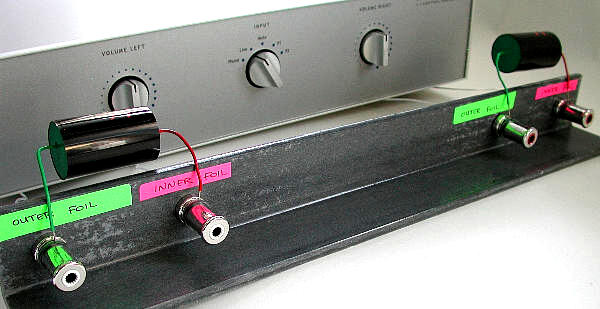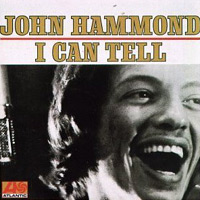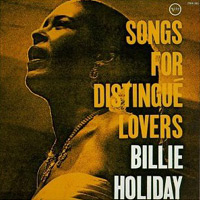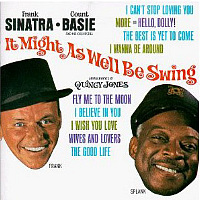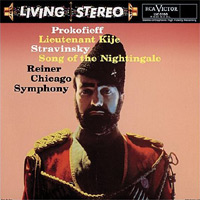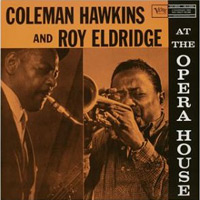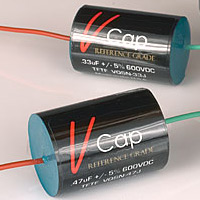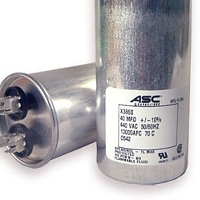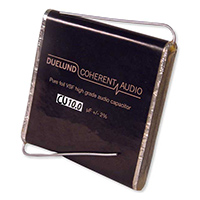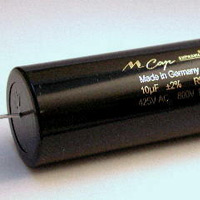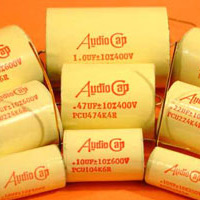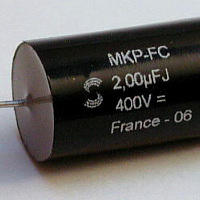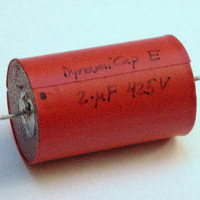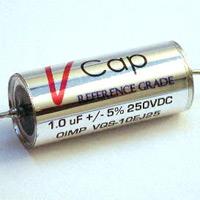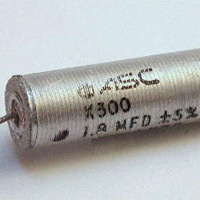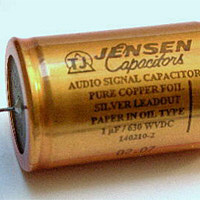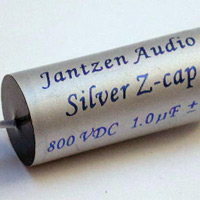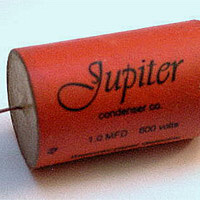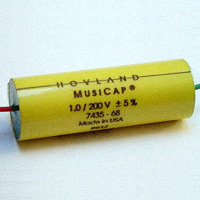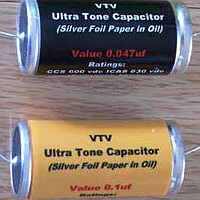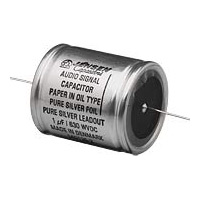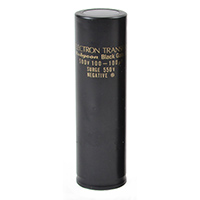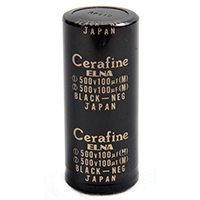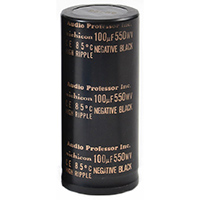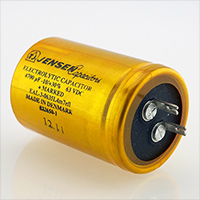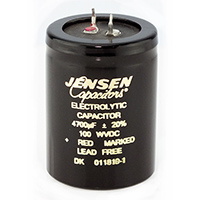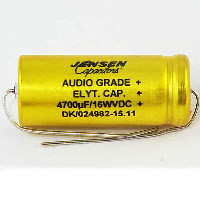The Great Capacitor Shoot-Out
a/k/a The Tempo Electric Cap Test
This survey was originally published on Tempo Electric, our commercial sister site, but was moved here (to The Vinyl Tourist) after we decided to remove editorial content from the Tempo Electric website. |  |
Latest Updates:
25 October 2018
In addition to adding and correcting some links to other shoot-outs, I've started to update the reviews with current prices, revised comments, and additional caps. Look for more to come in November-December, 2018, including (gasp!) some electrolytics that will beef up your power supplies.
9 May 2011
Added notes about the Mundorf MCap Supreme Silver & Oil to the Tier AA loudspeaker crossover comments, as well as added the VCap TFT to the Tier AAA crossover caps.
21 January 2011
There's an important update regarding the use of the Mundorf MCap Supreme in the Tier AAA AC Line Filter comments, as well as additional comments about the Cardas Golden Ratio and Hovland MusiCaps on Tier C.
12 October 2010
We're beginning another round of tests, using a new loudspeaker crossover as the subject. The speakers in this trial are a pair of full-range, 15" Tannoy dual-concentric drivers, circa 1980s, mounted on open baffles The major trials are expected to take place later in 2011.
1 November 2009
Added notes about the cost of Duelund Silver capacitors (see Tier AAA) and the apparent demise of VTV (see Tier X).
31 August 2009
The survey was moved here from Tempo Electric.
9 August 2009
In reviewing the new tier designations, we felt that placing the entry-level, polyester caps rated for AC Line FIlters on Tier A was higher than they should be positioned, so they were moved down to Tier B.
14 July 2009
The letter designations of each tier were revised. In the course of researching an unrelated topic, we came across a very long thead on the Audiogon Forums which began in May, 2008, and continues to this day. At one point, the original poster, Volleyguy, mentions that in our survey, "Jensen coppers were only Tier D."
It appears that the psychological implications of using sequential letter grades (similar to the grading system common in many public schools) tainted tiers C and D with the suggestion of failure, when just the opposite was intended. Under the original rating system, capacitors on Tier D occupied "The Great Middle Ground." This was actually where most of the samples ended up. In fact, if one were on a budget, this would be the logical tier to use as a shopping guide, because this was where many of the "best bang" capacitors were placed. Therefore, while the results have not been modified, we've changed the letter grades to more accurately reflect the psychological implications of each rating.
Coincidently, the same search which lead to the aforementioned thread, also turned up a blog called Jimmy's Junkyard, in which Jimmy talks about an "Extreme Capacitors Battle." While the battle still seems to be raging, a link to Jimmy was added to the other cap surveys, below.
3 May 2009
Modified the text and corrected several typos and grammatical errors throughout this page (ugh!). Given the cost of acquiring additional cap samples in today's economy, the Great Capacitor Rematch is being postponed again. With any luck, it will still happen by the end of 2010.
17 January 2009
The PentaCap seems to be back, but under the generic name of Custom Electronics's High Temp PTFE. Solen Teflon caps (as well as all other Solens) are much easier to obtain now, due to the installation of a shopping cart on the Solen/Canada website. We'll be buying samples of these, as well. A few more capacitors, including those from AmpOhm of Cornwall, UK, and ModWright Instruments of Amboy, Washington State, have been recommended as additions to the next shoot-out.
22 June 2008
Tempus fugit. We're returning to Plan A and saving the rematch for sometime in 2009. To this end, we have already obtained samples of the Sprague Orange Drops, the VTV Silvers, a previously unknown (to us) foil-in-oil called the Allesandro, and an offer from Audio Note (UK) to loan us samples of their Silver Foil caps. We plan to test their copper and aluminum foils, as well.
To these we'll be adding the 630V Duelunds, the aura-T, the Solen Teflons, Illinois Capacitor's metalized polypropylenes, and a pair of NOS Wonder Caps. Unfortunately, the Penta Cap has been discontinued by the manufacturer.
24 May 2008
Added a note to mention that we are advancing the shoot-out (really a "sound-out") between the caps on Tiers A and B against those on Tier X to Summer-Fall, 2008. Also, after reviewing the notes, we made some changes to the order on Tier B : Electronics.
19-20 May 2008
No change to the survey, but corrected a couple of minor typos and clarified certain points in the methodology.
1 April 2008
First date of publication. |
Introduction
Early in the course of voicing our components, we decided to do away with preconceptions about the effect of one passive part or another on the sound. Without a means of comparison that leveled the playing field for all comers, we were in danger of making arbitrary choices based on cost or rumor. With capacitors being one of the largest variables, we needed a method to show how they performed in different circuits under "real world" listening conditions. Of course, despite our attempt at objective evaluation, in reality, these opinions are highly subjective and based solely on our own listening tests in our own projects.
Disclaimer No.1
- This is just a guide,
- These trials were performed on a limited range of components and your experience may vary greatly,
- Caveat emptor, and
- Except as a customer, no one associated with these trials has any current or past financial association with any of the manufacturers mentioned.
The Burn-In
Although we were initially skeptical, it soon became apparent that capacitors need various burn-in times to reach their full sonic potential. Since the VCap TFTF had the longest recommended burn-in of 400 hours, we used that as a benchmark for all of the candidates.
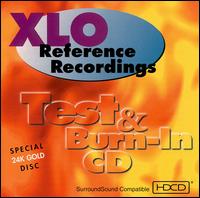
To facilitate burn-in prior to listening, we fabricated a dual-mono line stage, in which the only capacitor in the audio circuit came after the 5687 amplifier tube. In place of the cap on the circuit board, we installed a set of 12-position terminal strips, with a gap between them where the caps would normally be soldered. On each of the two boards, the terminals of each strip were strapped together and as many capacitors as would easily fit at one time were installed in parallel.
Each board had its own power supply (not shown) and Track 9 of the original XLO Test & Burn-In CD was used as the audio signal. This track consists of a 20Hz - 20KHz sweep tone that goes on for several minutes. It was copied as the sole cut onto a CD-R and a harmon/kardan CD player was set on "Repeat" so that the burn-in track played continuously for a minimum of 400 hours (about 17 days). The output signal was run to ground to complete the circuit without the need for an amplifier or loudspeaker.
The Test Set-Up
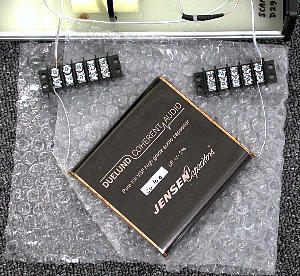 Soldering and desoldering dozens of capacitors can be messy and time consuming, enough so that it's easy to lose the aural memory of the previous audition. To speed things along, we also replaced the cap under test with a terminal strip that sat outside the chassis of the component under review. In the case of the preamp, it was a special jig made with binding posts mounted on a fiberglass rail, shown in the photo, below. This was attached to the cap's position in the circuit by a pair of silver wires--one in and one out. This way, the subjects could be replaced rapidly and were swapped in less than a minute, allowing us to retain the aural memory of the reference recordings. Soldering and desoldering dozens of capacitors can be messy and time consuming, enough so that it's easy to lose the aural memory of the previous audition. To speed things along, we also replaced the cap under test with a terminal strip that sat outside the chassis of the component under review. In the case of the preamp, it was a special jig made with binding posts mounted on a fiberglass rail, shown in the photo, below. This was attached to the cap's position in the circuit by a pair of silver wires--one in and one out. This way, the subjects could be replaced rapidly and were swapped in less than a minute, allowing us to retain the aural memory of the reference recordings.
While some caps had their outer foil clearly marked (VCap, Hovland, and so on), the RelCaps (among others) were sometimes a problem. When we bought RelCaps from Michael Percy Audio, the outer foil was already marked by MPA. Otherwise, we used an oscilloscope to locate it ourselves. To do this, we attached the hot and ground wires of the scope's probe to each lead of a given cap and placed the cap perpendicular to an active AC line, such as the power cord of the scope, itself. We observed the noise pattern on the scope, reversed the leads, and determined that the correct orientation was the one in which the scope's pattern display was the shortest in height. That is to say, when the display was the shortest, the scope's probe ground connection was considered to be connected to the outer foil of the cap.
Unfortunately, as the value of the cap increased, so did the difficulty in seeing any difference in the height of the test pattern. For more on the topic, see a comment from Aiken Amps, as well as this technical paper from an engineer at SBE Electronics, the current manufacturer of Sprague capacitors.
From a practical point of view, we tried reversing the caps in certain test applications and often, but not always, heard a difference. When they were orientated with the outer foil lead connected to the point of lowest impedance (either to ground or towards the plate of the previous tube), the sound was a little bit cleaner and more detailed. However, for most listeners (and with most caps), the difference was extremely subtle.
As appropriate, all of the candidates were tried in several different circuits. They were used as follows:
- As coupling and output caps in the RIAA circuit of the 1.1 Phono Stage
- As the output (and only signal path cap) in the Active Line Stage of the 1.1 Control Preamplifier
- As the cathode to ground bypass off the driver tube of the Model 302 SET Mono Amplifier
- As storage capacitors in the power supply of the Model 302 SET Mono Amplifier
- In the series loudspeaker Crossover of the EP-1 Loudspeaker, in which there is only one cap and one coil in the signal path
- As power line filters in a 120V AC distribution center
The electronics were mainly tested with 0.10uF and 1.0uF values, the loudspeaker Crossover with a 10uF value, and the power supplies with a variety of values, up to 60uF. Surprisingly, many that performed well in high-voltage applications were often not as happy in the speaker Crossover and vise versa. To be fair, there were probably many caps which did not sound as good in the high voltage applications which, if available in the 10uF value, might have performed better in the x-over. However, we were limited by the requirements of the circuits under scrutiny. The fact that a particular brand is not mentioned under a given catagory is an indicator of this limitation.
As we found out, price was not always a measure of bliss. For example, the best cap in the power supply was also the worst one in the signal path. Interestingly, when we experimented with two different Active Line Circuits, one self-biased and one fixed-bias, we came up with a somewhat different pecking order. Later, by coincidence, circuit designer and listening panelist Dr. Arthur Loesch used two of the lower tier finishers as coupling caps in his personal phono stage, where their major flaws largely cancelled each other out. This is why we suggest using the results, published below, as a guide, and not take them as an absolute. Voicing your components is a lot like cooking -- some spices work well in some recipes, but used in the wrong combination, they can easily make a dish unpalatable. If you do your own tests, please keep both your mind and ears open and try to forget everything you may have read about a given cap in this or any other survey.
For these trials, the entire collection was run through each circuit using the same overall setup (same preamp, amp, speakers, and so on), with no other changes. The group under evaluation was always auditioned in one continuous session and, on any given day, we always listened to the same reference cuts (usually four) in the same sequence, whether on LP or CD.
The listening panel varied from session to session, but often present, in addition to Dr. Loesch, were Bob Cummings, Yves Nazon, and, on occasion, Pern Van Camp, Paul Philips, and Vern Ohlke, as well as yours truly, Joseph Levy (who occasionally listened solo). The panelists were all experienced DIYers, each of whom has been involved with audio for 20 years or longer, and whose tastes tended towards SET amplifiers and Tannoy (or similar) monitor type loudspeakers. In fact, except for the AC distribution center, all of the components were designed by Dr. Loesch, himself, and constructed under his supervision.
While these were not "blind" tests in the strictest sense, where the set-up was hidden behind a screen, JL played the role of techie, switching the subjects in and out, and the panel was generally unaware of which cap they were listening to at any given time. They were also unaware of the price point until the final pecking order was announced. While the order of play was seeded, much like a tennis tournament, in which those with the lowest expectations were installed first followed by those for which the expectations were the highest, the end result often differed in the final sequence. With few exceptions, there tended to be general unanimity among the panel members about the attributes and deficiencies of each subject. JL kept notes about the individual comments and these are summarized below.
After the first round, the caps were sorted into three groups, based on initial impressions, and each group was later revisited two or three times for further refinement. Ultimately, the top performers on the list (Tiers AAA and AA) typically finished in the same order, regardless of where they were used. However, the greatest differences were always heard when the caps were closest to the signal source, such as in the first stage of the phono circuit or as the sole cap in the active line stage. As the signal was processed further, the differences (and improvements) were less apparent as more parts (resistors, tubes, wire) came into the mix.
As an aside for the DIYer, if money is an object, our experience suggests that it makes more sense to put the best parts up front and save money further down the line. For example, when used as the output cap of the third stage of the phono circuit, we heard little difference between the VCap TFTF Teflon and the REL AudioCap RT polystyrene. However, in the first stage, the VCap was clearly the winning choice.
We should add that these tests were run off and on over the course of two or three years. As the unit under review (amp, preamp, or speaker) underwent revisions and became more of a reference for the rest of the system, the tests were repeated at least twice for each component, revealing further differences that had been previously hidden. Each component underwent at least three major revisions, each version subject to retesting.
Finally, electrolytics were excluded from these trials simply because, with one exception (a 10,000uF value in the 6.3V regulated filament section of the 1201B+ Power Supply), we don't use them in any of our components. From past experience, even the best electrolytics are inferior to film & foils.
Disclaimer No. 2
If you try these tests at home, in your own components, be aware that capacitors can store lethal voltages that may kill you. Never touch uninsulated leads while in use and always discharge them by carefully shorting the leads after testing. The preferred method to insure this is to install a bleeder resistor across the leads of the capacitor so that the cap is discharged upon turn off. Failure to do this could turn you into the tasty bits of a burnt weenie sandwich, but you knew that already, didn't you?
Further Reading
While we were certainly not the first to conduct this sort of survey, we feel confident in saying that this is the most scientific, albeit subjective, series of trials to date in both its scope and in the methods employed. For your further edification, seven other capacitor shoot-outs can be found here:
The Music
With the exception of Famous Blue Raincoat, we typically listened to live performance or studio recordings that were made without overdubs. We tried to listen to the same cuts on both LP and CD and selected an assortment which featured male and/or female vocals, jazz ensembles, a blues band, and a couple of orchestral pieces. These were not specifically "audiophile" recordings or pressings, but ones that were well-recorded with a wide dynamic range, a variety of instruments, a distinctive space, or some other distinguishing feature.
LPs, and their primary reference tracks, included:
- Amazing Blondel, "Evensong," Evensong (Island ILPS-9136)
- Louis Armstrong, "None Of My Jelly Roll," Satchmo Plays King Oliver (Audio Fidelity AFLP-1930)
- John Hammond, Jr., "I Can Tell," I Can Tell (Atlantic SD-8152)
- Coleman Hawkins and Roy Eldridge, "Bean Stalkin'," At The Opera House (Verve MGV-8266)
- Billie Holiday, "Day In Day Out," Songs For Distingue Lovers (Verve VS-68257)
- Rickie Lee Jones, "Lush Life," Girl At Her Volcano (Warner Brothers 23805-1)
- Maria Muldaur, "Richland Woman Blues," Richland Woman Blues (Grooveland AGRD-108)
- Mussorgsky/Ravel, Pictures At An Exhibition, "Night On Bald Mountain," Fritz Reiner and the Chicago Symphony Orchestra (RCA LSC-2201)
- Prokofieff (sic), Lieutenant Kije, Fritz Reiner and the Chicago Symphony Orchestra (RCA LSC-2150)
- Frank Sinatra and Count Basie With His Orchestra, "Fly Me To The Moon," It Might As Well Be Swing (Reprise FS-1012)
- Jennifer Warnes, "Bird On A Wire," Famous Blue Raincoat (Attic LAT-1227)
CDs, and their primary reference tracks, included:
- Dave Alvin, "Goodbye Again" (with Rosie Flores), King of California (Hightone)
- Eva Cassidy, "Cheek To Cheek," Live At Blues Alley (Blix Street)
- Coleman Hawkins and Roy Eldridge, "Bean Stalkin'," At The Opera House (Polygram)
- Billie Holiday, "Day In Day Out," Songs For Distingue Lovers (Verve)
- Maria Muldaur, "Richland Woman Blues," Richland Woman Blues (Stony Plain)
- Mussorgsky/Ravel, Pictures At An Exhibition, "Night On Bald Mountain," Fritz Reiner and the Chicago Symphony Orchestra (Classic)
- Prokofieff (sic), Lieutenant Kije, Fritz Reiner and the Chicago Symphony Orchestra (Classic)
- Frank Sinatra and Count Basie With His Orchestra, "Fly Me To The Moon," It Might As Well Be Swing (Reprise)
- Sunnyland Slim, "Got A Thing Going On," Live At The D.C. Blues Society (Mapleshade)
- Jennifer Warnes, "Bird On A Wire," Famous Blue Raincoat (Cypress)
A Note About Manufacturers
It may come as a surprise to some, but REL (Reliable Capacitor) and ASC (American Shizuki Corporation) are among the few companies that wind their own capacitors in their own facilities. Most boutique American brands are actually fabricated by RTI Electronics of Anaheim, California, though their high-end audio cap production is now a subsidiary of Electrocube. They boast of making the Cardas cap and, based on their appearance and quality of construction (which is generally high), are probably the OEM for the VCap line (on dedicated equipment--not their regular line), as well as the Hovland Musicap, SoniCap, and many others. [Except for Cardas, for proprietary reasons, no one will confirm or deny any of these specifics.]
While the VCap OIMP bears a strong external resemblance to those made by Arizona Capacitor (formerly WestCap) of Tucson, Arizona, VCap said specifically that their products are not rebranded "house" caps, but their own unique designs, and a former engineer for Arizona Capacitor confirmed that they were never the OEM for the VCap oil series. The ASC X300 was relabeled and sold as the original TRT DynamiCap (we have examples on hand with both imprints on the wrapper), but current production may be by another firm (or not). In Denmark, Jensen rolls their own, but they are also the OEM for Duelund -- it's printed on the wrapper. For many years, Jensens were also relabeled for Audio Note UK and sold under that brand and we have observational evidence to suggest that Jensen may be the OEM for many of Mundorf's capacitors.
None of this should be taken as an inference of deception or to question the quality of the products under scrutiny, but simply as a note FYAI (for your audiophile information).
2019 Update: In 2019, Jensen ceased production of all audio grade capacitors and sold their equipment to Duelund.
The Results
We had over 36 different examples on hand. Most of them fell somewhere in the middle of our test results and had relatively few good or bad characteristics to distinguish them, other than price. That's not to say they all sounded alike. It simply meant that their sound was not as different from one another as one might have expected. It's interesting to note that two of the manufacturers, VCap and REL (the latter also makes the MIT Multicap), appear on both the upper and lower tiers. Some bargain caps were near the top and some pricey caps were near the bottom. So, brand name and cost weren't always a guaranty of compatibility with our set-up. Surprisingly, after the relatively new VCap TFTF (first introduced in June, 2004), the ones that always sounded the best here were the REL film and foils, which have been around for decades.
The results have been sorted by application and listed in order of most favored first. Prices, shown for comparison, are typical "street" or retail, not MSRP (Manufacturer's Suggested Retail Price), for a single piece in US$, in North America as of March, 2008.
Where available, links (in Blue) are provided to the manufacturer's or distributor's website.
Manufacturers are welcome to comment and we will be happy to add their views, as appropriate.
Disclaimer No. 3
We can't emphasize this enough:
- These ratings are purely subjective.
- They are based on a consensus of opinions.
- They are not the last word.
- Your experience may vary.
Tier AAA : Best In Class
Buy them when cost is no object and place them closest to the source when it is.
Electronics:
- Jupiter Copper Foil
Pure Copper Foil, Paper & Wax
1uF/600VDC = $132.00
After several years of development, Jupiter has come up with a cap that rivals Duelund's RS (which follows) and, if you believe the other surveys, it rivals the CAST-PIO, as well. While I have no personal experience with the latter, the Jupiter Copper & Wax gives the RS a run for its money. Unlike other listeners, I really don't detect much of a difference in overall balance or neutrality, which are outstanding in both series. However, I will give an edge to the Jupiter in terms of sound stage. In comparing two Larry Moore designed DACs, one with RS output caps (a dB Systems Tranquillity SE) and the other with Jupiters (an UltraFi DAC-41), the DAC with the Jupiters seems to have a larger, wider presentation, with more air around the individual performers. Of course, this could also be a function of the DAC-41's revisions, as well as the custom outboard power supply that was added later and is not standard issue. Either way, this is an exciting addition to the state-of-the-art in audio capacitors. One caveat -- unlike the RS, the Jupiters must be burned in for 100+ hours before their magic is revealed.
- Duelund RS Cu
Pure Copper Foil & Waxed Paper
1uF/400VDC = $171.34 List Price ($119.64 Discounted Price)
Call this Duelund's "budget" perfectionist cap. They're not inexpensive, but they are worth it. My earlier written comments about the VSF (which follow) apply here, too. When used in the best components, veils are lifted, music flows in a delicate stream, and contentment reigns. What about burn-in time? We thought they sounded great upon installation and only improved with time. So, don't deprive yourself by waiting 100 hours while pink noise permeates your listening room -- install, sit down, and listen!
- VCap TFTF
Teflon® Film & Tin Foil
1.0uF/300VDC = $269.99
With a 400 hour break-in (200 hour absolute minimum), we once complained that these weren't a "real world" product. However, they really are worth the wait. There's simply less "there" there than with any other capacitor we tried in any high voltage, audio signal circuit. They are more transparent, more detailed and, well, more of everything that you're looking for. Or perhaps less of everything you'd like to avoid. Properly placed, they'll reveal more of the ambient clues that distinguish individual sound spaces, as well as the individual voices and instruments within them.
While you may be tempted to use the TFTF everywhere in a given circuit, they still have a sonic signature. Use them up front or in the most critical positions where you'll hear the greatest improvement. Use too many in a row and you'll hear the distinct, somewhat cool sound that is typical of the Teflon dielectric. Neither are they a cure-all for a badly designed circuit. In such situations, they'll simply reveal all of the flaws that were previously masked. Downside: Very pricey, even if you're an OEM, like us.
Chris VenHaus (the "V" in VCap) comments, "Although the V-Caps aren't marketed as being 'burned-in' or 'conditioned,' they do undergo at least 100 hours of 'burn-in' at rated DC voltage, during the testing process. I suspect other companies may be marketing a similar process as 'burn-in.' I don't consider a cap 'fully-cooked' unless an AC signal has also been put through the cap for an extended length of time. Mechanical stresses during installation of the units are also a likely cause that lessens the effectiveness of pre-conditioning, in my experience.
"Also, in my experience, 'conditioning' will eventually dissipate over time (as with cables conditioned on a cooker), if the cap is left on the shelf for a lengthy period of time. Therefore pre-conditioning isn't feasible unless doing it right before the caps are shipped. I simply haven't found this to be an efficient option to offer."
This appears to be a reference to a rival Teflon cap from another manufacturer. In response to the TFTF's notoriously long break-in period, the competing product is being marketed as "pre-cooked to reduce burn in time." However, back in the lab, we found that once broken-in, the caps under test never fully regressed to their "raw" state, even if left unused for six months. Upon revisiting, they typically confirmed our earlier impressions.
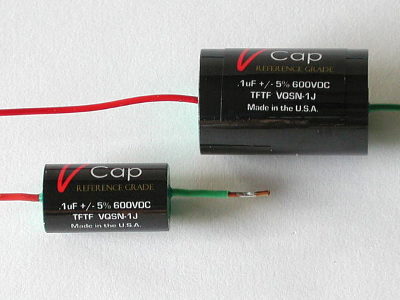 0.10uF VCap TFTF: 0.10uF VCap TFTF:
Original (lower left), New & Improved (upper right)
Update: As of January, 2007, all values from 0.47 uF and below are wound with a thicker Teflon film. In comparing the old with the new, we heard an audible, though subtle, improvement. A touch more "air" separating individual instruments, a bit more overall transparency and detail. At this level, it's difficult to quantify, but one could easily call it a 5% overall improvement. Should you toss out your early production VCaps in favor of the latest ones? Only if this sort of thing keeps you up at night.
NB: Some values have also been derated from 600 volts DC to 300 volts DC, maximum.
Chris VenHaus comments, "The original production TFTF's are still fine at 600V, including the older, larger values over 0.47 uF (that were subsequently de-rated to 300V for NEW production). It was only when the NEW DuPont Teflon was supplied, that we felt we needed to derate the caps accordingly. Whether it was a tooling or reformulation at DuPont, we don't know, but something changed and newer film from our supplier wasn't making our conservative ratings any more."
Loudspeaker Crossovers:
- Duelund RS Cu
Pure Copper Foil & Waxed Paper
10uF/100VDC = $749.91 List Price ($522.84 Discounted Price)
This lower voltage version of the RS is designed for use in the crossovers of loudspeakers worthy of the best components. Comments, above, apply here, too. This is especially true if you use them in the midrange and tweeter paths -- if funds allow, use the VSF on your woofer's signal path. However, if you can't afford the VSF or CAST series, use the RS throughout. If you're into your speakers for the long haul, you won't regret it.
- Duelund VSF Cu (Virtual Stacked Foil)
Pure Copper Foil & Paper In Mineral Wax
10uF/200VDC = $803.00 List Price ($682.55 Discounted Price)
A clear improvement over the runner up. Brass instruments sounded more like brass, violins sounded more like violins, and so on. Everything was cleaner, smoother, and exhibited less glare. Previous to installing the Duelunds, we thought the (now) runner-up was so good that we didn't recognize its flaws until they were gone. As noted by other reviews, their strength is in the mid-range and bass. In the treble range, they exhibit a slight roll-off, so keep them in the lower octave section of your crossover's signal path. Use the RS (above) or CAST series in the tweeter line.
Downside: Again, the price. In North America, a pair of 10uF VSF Copper Foil Duelunds sells at Parts Connexion for the discounted price of $1,365.10. While there was an audible improvement over the Tier AA Mundorfs (commonly found for $114.80 per pair in the same value), it was perhaps two or three-fold, rather than 13-fold. Should you upgrade? If you have a pair of speakers that you've already spent $2,000 or $3,000 on, are wedded to for the long haul, and which have a minimal number of caps in the x-over, then they are definitely worth the money. Otherwise, the regular Mundorf MCap Supreme may be a better value. This is especially true for less costly speakers where the advantage of the Duelunds may never be heard (would you mount a $7K ZYX UNIverse cartridge on a vintage AR XA turntable?).
The VSF series is also available in Aluminum and Pure Silver Foil versions for $233 and over $6,000 each, respectively (yes, you read that last figure correctly). However, our experience with other caps made from similar materials suggests that in terms of value for the money, Copper Foil is the way to go.
Update: Duelund has since introduced the CAST PIO (Paper-In-Oil) series. With a retail price of $1,268 each in Copper and over $8,000 each in Silver Foil (10uF values), we can only guess at how good they may be.
Frederik Carøe of Duelund comments, "I agree that silver caps are very expensive indeed, but looking at the cost of the final product versus the cost of the material used, they are not unreasonably priced. Certainly no where near quite a few examples in audio."
In an age of $17,000 phono cartridges, $30,000 speaker cables, and $120,000 turntables, he could be right. On the other hand, silver bullion is selling today in the range of $15.00 per Troy ounce (13 Euros per 28 grams). How much silver is really in these things, anyway?
Update: 1 November 2009. Apparently, my attempt at rhetorical humor has caused several readers to contact Mr. Carøe and ask that very question. In Duelund's defense, he wishes to note that the Silver CAST capacitors (as well as the SIlver VSF) are fabricated with pure silver foil, rather than metalized film. In addition, they are basically made to order by hand and not mass produced on an assembly line. I should mention, too, that silver foil is at least 400% more expensive than bullion or coin silver. Having said that and knowing something about the cost of manufacturing, it's safe to say that the actual cost of materials for most goods (and not just in high-end audio) is about 10% to 20% of the final retail price. To put this into perspective, it is safe to guess that the materials required to produce a 10uF Silver CAST capacitor cost between $400 and $800 USD. Add to this the cost of labor, overhead, profit, and the retailer's mark-up and it's easy to see how the final price can seem out of proportion to the product, itself. Think of the Silver Duelunds as the Koenigsegg of capacitors and perhaps you'll feel better about the whole experience.
- VCap TFTF
Teflon® Film & Tin Foil
1.0uF/300VDC = $269.99
Update: May, 2011. We recently tried these in a new crossover that only used one cap in the signal path and can confirm that all of the virtues mentioned in the electronics review, above, are present in this application, too. While the Duelend has a slightly more "analog" sound, overall it's a very close call.
Power Supplies:
- ASC X386
Metalized Polypropylene In Mineral Oil
50uF/500VDC = $15.39
If space allows, this capacitor-in-a-can is superior to any electrolytic on the market, period. This includes Black Gate, Nichicon, or Panasonic. For curiosity, we tried a 2.0uF ASC X386 in the signal path, but ended the experiment after 30 seconds. Keep them in the power supply section, especially of amplifiers, where they belong. Though there is a point of diminishing returns, the higher the value, the tighter and deeper the bass will be. Even ones with 10% rated tolerance measured within 1%. Also sold under the Angela Instruments brand. Primarily rated for use with AC, they can be used in DC applications, as well. Curiously, they did not perform as well when used as AC line filters (see below). Downside: Large size, awkward mounting.
- Wima MKP 5 DC-Link
Polypropylene Film
55uF/1300VDC = $43.58
Also called DCP 5, these relatively new caps from Wima of Germany are the best choice in very high voltage applications, such as 211 or 845 power tube amplifiers, as well as any other tube power amp. They're available in limited values rated at 500VDC to 1300VDC and may be difficult to find in stock outside of Europe. They're not small, so be sure to take measurements and make sure you have enough real estate for mounting.
- Audio Note (UK) Kaisei [pronounced KY-say]
Electrolytic
Various Values and Ratings
Translating as "Revision," the Kaisei capacitors are the designated successors to the Black Gate electrolytics. They were commissioned by Audio Note (UK)and the OEM for this line is Rubycon of Japan, originator of the Black Gate caps, mentioned next. As of this writing (February, 2019), I have a few placemarked for use in a few different components and cannot comment first hand. However, Dr. Slawa Roschkow of SW1X Design has done extensive comparisons of several well-regarded electrolytic types, including original Black Gates, and has enough to say about the Kaisei to direct you to his page for his impressions (which are quite favorable).
- Black Gate, Cerafine, and Audio Professor
Electrolytic
Various Values and Ratings [All now discontinued]
In the 1980s and 90s, these were the big three in electrolytic power supply caps. Rubycon's Black Gate SKZ and Heart of Muse were acknowledged to be the leaders, followed by Elna's Cerafine, and Nichicon's Audio Professor. Even when new, they were pricey at $100+ for high capacitance, high voltage models. Today they are still prized and used examples bring as much or more than their original price tags. Beware, however, of counterfeits from Asia. Dealers in Hong Kong, China, Taiwan, and elsewhere who seem to have unlimited supplies of NOS Black Gates or the other brands should not be trusted. Manufacturing ended in the early 2000s and very few authorized dealers have original stock on hand.
- Jensen
Electrolytic, Axial and Radial Styles
60uF/500V = $23.20 Axial Black
4700uF/63V = $35.95 Radial Gold
100uF/500V = $39.13 Radial Black
If you don't have room to mount the ASC X386 or Wima MKP 5, then these compact electrolytics are the best available today. They give you a rich, full tone with lots of bass energy. I replaced the generic caps (unmarked, but probably Nichicon or Cornell Dubilier CDE) in a dB Audio Labs Tranquility Signature Edition DAC with similarly rated Jensens and they easily kicked the DAC's performance up a level on the Darko DAC Index. Replacing the output caps with a pair of Duelund RS copper foils, pushed it up another level to Division 1, as well. Available in single-section axial, as well as single and dual-section radial styles, in a wide variety of values and voltage ratings.
AC Line Filters:
Update: January 2011. A correspondent contacted Mundorf Gmbh in Germany and was informed by Norbert Mundorf that the MCap Supremes "are not X/AC designated." Obviously, I was mislead by the AC rating printed on the cap's wrapper and suggest that you take this into account.
In my own DIY AC line filter, I use a Brick Wall surge suppressor ahead of all caps. Unlike MOV's, it will not deteriorate and fail over time—at least that's the manufacturer's claim.
In theory, the Brick Wall should keep any power surge from reaching the caps to begin with, so that any cap from any manufacturer should be safe to use behind it in this application. Mundorf MCap Supremes still have an advantage because their high DC rating means that the insulating film is relatively thick. In addition, they come in unusually high values for a film-type cap. However, without the Brick Wall or a large bank of MOV's in place, I'd recommend looking for the highest value type X caps you can find -- especially those made with polypropylene or polystyrene film.
- Mundorf MCap Supreme
Metalized Polypropylene Film
1uF/800VDC = $23.00
By rights, the true winners were the VCap TFTF and REL AudioCap TFT. When compared to all others, the results with these Teflon® dielectric caps were consistently better. However, after consulting with both manufacturers, the consensus was that because of their construction, it was not safe to use them in an AC line. In several discussions about AC power conditioning on Audio Asylum, as well as on his own site, Jon Risch writes, "For any capacitor placed across the AC line, I recommend use of fully rated AC line parts, which are designated as an 'X' type." This was seconded by engineers at PentaCap and ASC whom we contacted about this issue. (For more technical insight, please read this white paper published by Evox-Rifa, Inc.)
In the event of damage from a momentary line spike (which can be as high as 1,500 volts), Type X caps have self-healing properties. Caps that are only rated for DC can potentially self-destruct, short-out, and ignite. If you're inclined to experiment, only use capacitors that have an AC rating printed on the wrapper. Don't take it for granted that any high-end cap is safe to use for AC, unless it is specifically labeled as such.
That said, of all the caps that were specifically rated for AC use, the Mundorf MCap Supreme cleaned up the line far better than any other. There was far less grunge, far more detail, and a greater sense of musicality when they were in place. Bass was deeper and richer, the mid-range was smoother and more detailed, and the highs exhibited far less glare. Though some experimenters advocate using the highest value that can comfortably fit, we made our tests with 1.0uF caps throughout. Later, we did substitute higher value MCap Supremes in key positions and found that hypothesis to be true. As the value increased, the music became far less grainy and much more fluid. Focus became tighter and sharper (in a good way). Available up to 22uF, though in the later experiments we determined that the best value and most dramatic improvement was in the 5.6uF - 10uF range.
Tier AA : Top Shelf Performers
These are still top contenders, some at bargain prices. Since every cap has a sonic signature, we always recommend a mix of brands in any given circuit to help cancel it out. We found these to be the best choices to mix with the ones on Tier AAA.
Electronics:
- REL AudioCap TFT Exotica
Teflon® Film & Tin Foil
1.0uF/200VDC = $203.50
The next best thing to the VCap TFTF -- in a direct comparison, they are just barely less transparent. However, lacking a direct comparison, it's hard to tell the difference. They sell for about the same price as the VCap, so why bother?
- REL AudioCap PCU Exotica
Polypropylene Film & Copper Foil
1.0uF/200VDC = $155.00
A slightly sweeter alternative to the ones above, with a smooth, relaxed sound. As with most copper foil caps, their warmer sound is in contrast to the Teflon's cooler characteristic. If the sound of Teflon and tin foil caps is like a silvery aura, then the sound of copper foil closer to a golden glow. One could argue (correctly), that the Teflons are (or can be) more neutral, but it's a matter of personal taste. Still pricey, though.
- REL AudioCap RT
Polystyrene Film & Tin Foil
1.0uF/200VDC = $22.50
Relatively inexpensive, given the quality. This one actually outperformed the SoniCap Platinum Teflon cap, which costs four times as much, with its smoothness and lack of glare. Has most of the qualities of the ones above for a fraction of the price. When money is a consideration, they're a good alternative to the pricier Teflon caps and the further down the signal path you install them, the more difficult it is to distinguish the RT from the best of the Teflons.
Loudspeaker Crossovers:
- Mundorf MCap Supreme
Metalized Polypropylene Film
10uF/800VDC = $57.40
All of the MCap Supremes are actually two higher value capacitors wired in series and placed inside a single wrapper. We found the original MCap Supreme to be the best reasonably priced capacitor available for loudspeaker Crossovers, today. It is rich, detailed, and full-bodied, though a bit softer sounding than the Duelund VSF. Relatively free of glare. Available in values up to 22uF.
- Mundorf MCap Supreme Silver & Oil
Metalized Polypropylene Film with Silver Flashing
10uF/1200VDC = $148.00
This is an oil impregnated, metalized paper capacitor, with the same series configuration as the original MCap Supreme. High-purity silver is used for the capacitor coating, and the winding is impregnated with a special oil. Despite the hype, we found the sound to be similar to the regular MCap, above. The major difference is that the sound spectrum shifted upwards, adding emphasis to the highs, at the apparent expense of the bass. While this creates a greater sense of air and transparency, the impression of a diminished bass response may not make it the best choice for a full-range speaker system.
It was actually a tough call whether or not to place this cap here or send it down to a lower tier. In some ways it was more coherent than the regular MCap Supreme, but the fact that it seemed to truncate the bass made it somewhat suspect for general use (especially for the price). By itself, it may be a better choice for 12" or 15" Tannoy or similar drivers or a simple fix for speakers that sound too dark.
Anecdotally, a number of listeners have disagreed with our assessment and feel that the balance is superior to the plain MCap Supreme, above. This may be a case where placement is really the final arbiter.
Update: Mundorf has also introduced two additions to the Supreme series: the MCap Supreme Silver & Gold, which adds 1% gold to the silver metalization, and the MCap Supreme Silver / Gold & Oil, which is a hybrid of the other two.
Update: May, 2011. Having now tried the Silver & Oil in a 15" Tannoy Monitor Gold X-Over, we still have the same impression as before. That is, we still prefer the Duelund VSF and regular Mundorf MCap Supreme to the Mundorfs with added silver, gold, and/or oil. While still a good quality product, given the other choices, the extra cost doesn't seem justified.
- SEC F-Dyne MPP1X
Metalized Polypropylene
25uF/200VDC = $50.00
Until it was acquired by Electrocube in early 2007, Southern Electronics Corporation was a specialty manufacturer located in Burbank, California. Virtually unknown in the world of DIY audio, they produced an excellent line of custom capacitors, mainly wound to order for OEMs. We tried their MPP1X polypropylene film & foil caps in a woofer network where they excelled with a clean, transparent sound at a bargain basement price. Unlike many boutique manufacturers, SEC's prices were based more upon the actual cost of production, rather than what the market would bear. Although Electrocube says they will continue to offer SEC products, it's unclear if these will really be the same.
Update, January, 2009. A correspondent wrote to say that he contacted Electrocube and that Michael Tong, one of the principal managers at SEC, is still there and that the plant is still functioning. However, there is now a 100 piece minimum order for any value.
Power Supplies:
- Mundorf MCap Supreme
Metalized Polypropylene Film
10uF/800VDC = $60.00
Same comments as above. Available in values up to 22uF.
- Solen FastCap MKP
Metalized Polypropylene
47uF/630VDC = $17.95
Another good choice for power supplies. Ironically, because they're available in very high values, these are often used in speaker Crossovers where they didn't fare so well in our tests. If you have the space, they're another logical alternative to electrolytics. Also labeled SCR and available in values up to 220uF at 400VDC. Rated up to 1200VDC under the AXON brand.
- Mundorf MLytic HV+
High Voltage Electrolytic
100uF/550VDC = $33.50
A slightly more affordable alternative to the Jensen electrolytics, above. A good choice when space and budget are a consideration. Available in values up to 470uF.
Tier A : Affordable Quality
These are still good choices and generally more affordable than Tiers AAA and AA.
Electronics:
- TRT DynamiCap-E
Metalized Polypropylene Film
1.0uF/425VDC = $21.00
Has a slightly softer sound than the film and foil caps, but is smooth, musical, and relatively glare free. It's a cap that really does nothing wrong and is a no-brainer when Teflon is out of your price range.
- Mundorf MCap Supreme
Metalized Polypropylene Film
1.0uF/800VDC = $23.00
- Mundorf MCap Supreme Silver & Oil
Metalized Paper
1.0uF/1200VDC = $50.00
Comments, above, about their use in speaker Crossovers, apply here to both of the MCap Supremes. Properly placed, they can mitigate the hardness of a digital front end. You can safely use them anywhere that fine caps are called for.
- REL AudioCap PPT Theta
Polypropylene Film & Tin Foil
1.0uF/200VDC = $12.00
In comparing the REL RT and REL AudioCap Theta, depending upon how they are used, each one has a slight trade-off (or advantage) relative to the other. The RT is slightly more etched (detailed or analytical), but the Theta is a bit smoother. The down-side with the Theta is a slight loss of detail, though many listeners may prefer its more liquid (and forgiving) sound. In voicing our phono preamplifier, a 5.0uF Theta, used as an output cap, was slightly lackluster, but we were able to balance it nicely by using a 0.033uF REL RT polystyrene as a bypass cap. Another sonic bargain, almost as good as the ones in Tier AA, that will benefit from a very small value polystyrene or Teflon bypass.
Loudspeaker Crossovers:
- TRT DynamiCap-L
Metalized Polypropylene Film
10uF/310VDC = $43.95
As with the E-type, the "L" has a slightly softer sound than the film and foil caps, but is smooth and relatively glare free.
- VCap OIMP
Oil Impregnated Metalized Polypropylene Film
1.0uF/250VDC = $61.99
These were initially placed in Tier C under electronics, which they really weren't designed for. I'm including the original remarks, as they were tested, but advise that you use them as the manufacturer recommends in his comments, which follow.
Given Dr. Loesch's bias towards oil caps, we had high hopes for this modern type, but using it in our electronics was a disappointment. In the positions where we tried them (as coupling or output caps in the Loesch Preamp and as a 6350 tube's cathode-to-ground bypass in the 302 SET Amps), they made the sound slow, stuffy, and uninteresting. They seem to need a jolt of caffeine and might be best paired with a harder, brighter cap, like the Hovland or Electrocube or perhaps paralleled with a VCap Teflon bypass. As used in our circuits, especially in line with a TFTF, its flaws were difficult to overlook.
This was pretty much conformed by manufacturer Chris VenHaus's comments when he wrote, "Most of the applications the OIMP's are being used for are outside the scope of your testing. They're best suited for use as larger value output coupling caps (bypassed with a 0.01 TFTF—especially in digital circuits), as a bypass for electrolytic power supply filter caps, in a cascade with smaller value TFTF's, and in loudspeaker x-overs (although TFTF tweeter bypass caps work great on all but metal domes)."
Power Supplies:
- ASC X300
Metalized Polypropylene Film
10.0uF/200VDC = $12.00
The OEM version of the original TRT Dynami-Cap, the X300 exhibits a touch more glare, but costs a fraction of its upscale sibling. A good place for this economical cap.
- Mundorf MLytic HV
High Voltage Electrolytic
Axial and Radial
100uF/500VDC = $17.93
An even more economical alternative to Jensen and Mundorf HV+ caps. Still good quality, especially for the price. Available in values up to 560uF.
Tier B : The Great Middle Ground
This is where the largest group of candidates ended up. None were fatally flawed and each displayed its own distinctive flavor or coloration. Some genuine bargains abound.
Electronics:
-
Generic Russian Military Surplus
Teflon Film & Foil
0.10uF/500VDC = $1.00
Commonly found on eBay, their cost ranges from $1.00 to $4.00 each. Compared to the best American Teflons, they suffer from diminished transparency and detail. We should note that we only tried one sample, which happened to be fairly good sounding. There may be many variations from different factories, but unless you can decipher the codes, there is an element of chance involved in their purchase. Still, decent quality at a give-away price. If you're on a budget, they are definitely worth considering.
- Jensen
Copper Foil In Oil
1.0uF/630VDC = $46.25
A relatively smooth performer with a rich, transparent sound that's lively, musical, and spacious with a good mid-range. When used in the most critical applications, a touch of brightness and congestion may be apparent at the top. Careful, though! We've had two personal reports (and have seen several mentions in DIY forums) of these capacitors leaking oil, especially in high voltage applications. Still, we found them to be the best of the oil caps we tested for this type of circuit.
- SEC F-Dyne PST1X
Polystyrene Film & Tin Foil
1.0uF/200VDC = $8.00
Similar to the MPP1X, mentioned under Tier AA : Loudspeaker Caps, above. Slightly more refined with a better dielectric.
- SEC F-Dyne MPP1X
Metalized Polypropylene
1.0uF/200VDC = $5.00
See comments under Tier AA, Loudspeaker Caps, above. However, in some circuits we either heard a slight roll-off at the top or a bit of hardness.
- Sprague Vitamin Q
Paper In Oil
The classic oil cap from the 1950s, loaded with yummy PCBs. They have a smooth and somewhat soft sound which can be mitigated by pairing with a brighter or harder sounding cap farther along in the circuit. Commonly found on eBay, prices vary by value, rating, and scarcity.
- Sprague Generic Vintage
Paper In Oil
As with the Sprague Vitamin Q's, they have a smooth sound that is somewhat soft by today's standards. Not unpleasant, however, and very similar sounding to the Jensen copper-in-oil caps, above.
- Jupiter
Beeswax, Kraft Paper & Aluminum Foil
1.0uF/600VDC = $26.00
A exotic blend of unusual materials, the Jupiter cap is also similar in sound to the Jensen copper-in-oil, though a bit more recessed and a touch slower. While it's generally well-balanced (Jupiter calls it a "condenser"), in the wrong place it can have a tendancy to darken the sound. Ultimately, in electronics, we just found it to be uninvolving and suspect that its proper place is really in a loudspeaker crossover.
- Auricap
Metalized Polypropylene Film
1.0uF/200VDC = $19.39 [Now Discontinued]
Auricap is the successor to the Sidereal cap and bears more than a passing resemblance to the RTI F Series. The sound is smooth and detailed, with a full body, but glare in the highs becomes obvious when compared to the best. Imaging was less three-dimensional than the best, as well. Some values are rated for use up to 3000VDC.
Update: 3 May 2009. Originally, I added comments here by John McDonald, President of Audience AV, the maker of Auricap. However, after he saw his words in print, Mr. McDonald wrote back to say, "In my opinion, I think it is highly unprofessional for you to publish my personal comments to you without asking for permission," so I deleted his brilliant prose (which was simply an opportunity for him to talk in more detail about his product and to correct a few factual misconceptions). Apparently, Mr. McD forgot the line by Oscar Wilde, who quipped, "There is only one thing in life worse than being talked about, and that is not being talked about." Well, I think we've already talked enough about him, haven't we?
- RTI F Series
Metalized Polypropylene Film
1.0uF/200VDC = $20.00
As previously mentioned, RTI claims to be the OEM for 75% of the boutique audio caps on the market. Their F Series is sonically identical to the Auricap, above, and the same comments apply. While available for bulk purchase only, for a $5,000 minimum order, RTI will be happy to put your name on them instead of their own.
- Solen FastCap MKP
Metalized Polypropylene Film
1.0uF/630VDC = $2.25
One of the surprises of this survey was how well the Solen FastCap performed in high voltage applications. While not the last word in detail or transparency, it projected a big image. Depending upon its placement, it was either smooth from top to bottom with robust bass or it would exhibit a bit of glare or congestion on top, along with a lean midrange. Also labeled SCR and available in values up to 220uF at 400VDC. Rated up to 1200VDC under the AXON brand.
- ASC X300
Metalized Polypropylene Film
1.0uF/200VDC = $4.00
Very similar to the TRT DynamiCap-E, mentioned on Tier A : Electronics, above, but with a touch more glare at the top. Hard to find off the shelf, they still offer good quality for a very reasonable price.
- Jantzen Silver Z-Cap
Metalized Polypropylene Film with Silver Flashing
1.0uF/800VDC = 23.60
Introduced in early 2007, the Jantzen Z-Cap is available in several types. We tried their top-of-the-line Silver Z and found it to be detailed and spacious, though somewhat light weight in its presentation.
- Mundorf MKP
Metalized Polyester Film
1.0uF/400VDC = $2.00 [Now Discontinued]
Mundorf has since replaced the original metalized polyester line with a new range of lower voltage metalized polypropylene caps. Included out of curiosity, except for the Type X caps that were used as AC line filters, the ultra-cheap, original MKP was the only polyester cap included in this survey where it performed surprisingly well. What it lacked in air or detail, it made up for in overall smoothness and balance. If a rock bottom price is an absolute criterion, you could do a lot worse.
- Sonicap Platinum
Teflon Film & Foil (?)
1.0uF/400VDC = $97.80
Reported to have a Teflon dielectric, to our ears these sounded no better than the caps on Tier A. We thought the REL RT (at 1/4 of the price) to be clearly superior. Other than that, it has no major flaws, but is way overpriced for the sonics. Objectively, it should really be higher on the list, but was placed this low because of its cost.
- Sonicap Gen I
Metalized Polypropylene Film
1.0uF/200VDC = $5.80
While not offensive, it's is an inexpensive cap that sounds that way. Bargain hunters would be better served using a Russian Teflon or Mundorf MKP.
- CRC
Teflon Film & Foil
0.10uF/200VDC = $20.00
Now defunct, for many years Component Research Corporation was one of the few manufacturers of Teflon film caps. When compared to the latest generation from VCap and REL, they sound stuffy and veiled. Virtually impossible to find anymore.
Loudspeaker Crossovers:
- ASC X300
Metalized Polypropylene Film
10.0uF/200VDC = $12.00
Another good place for this economical cap.
- Kimber Kap
Metalized Polypropylene Film
10.0uF/200VDC = $36.00
Although we found these to be a big disappointment in electronics, we tried several in a loudspeaker crossover where they sounded clean and clear. Flaws were mainly those of omission.
AC Line Filters:
- Vishay/Roderstein Type F1778
Metalized Polypropylene Film
1uF/275VAC = $1.68
- Vishay/Roderstein Type F1773
Metalized Polyester Film
1uF/250VAC = $4.73
- Mallory Series 158X
Metalized Polyester Film
1uF/160VAC = $1.31
These are all entry level caps that are specifically designed as AC noise suppressors. They're decent performers and good values when price is a consideration. Because it's only rated at 160 volts AC, the Mallory 158X should not be used on 220 volt or 240 volt power lines.
Tier C : Unfulfilled Potential
This group should really be a subset of Tier B, but here the flaws, as we heard them, were more obvious. We really tried hard to like several of them and while many of these caps may perform well if placed in the right mix, they never sounded quite right anywhere we installed them. This doesn't mean you should ignore them, it just means they are somewhat fussy about where they can be used.
For example, in contrast to our reviews here, Dr. Loesch used a combination of Vitamin Q's and Electrocube 950's in his personal phono stage where they complemented each other quite nicely. While they both scored far down the list (Electrocube below and Vitamin Q on Tier B), when used together in the same circuit, what we perceived to be opposing negative characteristics happened to balance each other out. Sometimes, two perceived wrongs do make a right. In the end, this group was listed separately because they portended a greater potential for success than our tests could reveal.
Electronics:
- Cardas Golden Ratio
Metalized Polypropylene Film
1.0uF/600VDC = $72.08
Similar in construction to the Mundorf MCap Supremes, this is another cap in which two larger values are wired together in series under one wrapper. The Cardas, however, had a totally different sound from any other we auditioned. While it was clean, detailed, transparent, and musical, with a velvet-sounding midrange, it exhibited a very strong coloration that was hard to ignore. The opposite of the MCap Silver/Oil, it shifted the tonal range downward in any component in which it was used. Highs simply disappeared, suggesting these may have been designed with a digital front-end in mind. If you do try them, we suggest pairing the Cardas with something like the MCap Supreme Silver & Oil, so the virtues of each have a chance to be heard.
Further thought: This capsule review doesn't quite do the Cardas Golden Ratio justice. It's actually far better than you might imagine from this synopsis, but we kept trying it over and over and were frustrated at every turn. If it weren't for the truncated highs, it would certainly make it to Tier A.
Update: May, 2009. A listener recently called to mention that his preamp used both Cardas and Kimber caps in the signal path, with respectable results. This is another example of how two caps, neither of which rated very highly on our list and which have somewhat opposing sonic characteristics, may be able to work together despite what we perceived of as major flaws.
Update: January, 2011. Another correspondent wrote to say that "the Cardas caps do not come into their own until at least 500 hours, and the folks at Cardas told me that they have had reports of as much as 1000 hours needed for a full break in..." If that's true (and this was the first time we've heard this comment), then our 400 hour burn-in (plus another few hours in the test rigs) certainly wasn't adequate. In modifying the sound of an amp, he went on to write, "The Kimber/M-Cap combo that was [already] in place sounded pretty much like your description would suggest, harsh and aggressive, so I looked down your list for something to tame the highs rather than accentuate them. The Cardas Golden Caps fit the bill perfectly! While they would probably not be the first choice for some systems they were perfect for my application, which I would never have known if your tests had not been available."
- Hovland MusiCap
Polypropylene Film & Tin Foil
1.0uF/200VDC = $15.95 [Now discontinued]
A popular cap with a smooth, spacious sound, the Hovland added just enough hardness to make our tubed circuits sound more like solid state. If you like to bypass one cap with another (we generally don't, because we feel it obscures detail), then paralleling it with a small value VCap OIMP (below) might remedy this problem.
Update: January & May, 2011. It recently came to our attention that the original Hovland company ceased operations in the fall of 2010, a victim of the world-wide recession. However, Alex Crespi, one of the former Hovland principals, has reintroduced the MusiCap (somewhat modified) as the UpTone Audio MusiCap. In addition, Robert Hovland has introduced a new cap under his own name. We may give both another shot and, if so, will provide further updates.
- Electrocube 950
Polypropylene Film & Tin Foil
1.0uF/200VDC = $5.00
Comments about the Hovland apply here, too.
Loudspeaker Crossovers:
- Solen FastCap
Metalized Polypropylene Film
47uF/630VDC = $17.95
Because they're available in very high values, these are often used in speaker Crossovers where they are really not that good. When compared to their betters, they sounded slow and congested. Available in values up to 220uF at 400VDC. Better used in high voltage applications where they are excellent alternatives to electrolytics. Also labeled SCR and AXON.
AC Line Filters:
- ASC X386
Metalized Polypropylene Film In Mineral Oil
1uF/440VAC = $4.00
Given their strong showing as a DC power supply capacitor, we expected the X386 to perform equally well as an AC power line filter, which is one of their primary design applications. While not completely unpleasant, we found that they added a hardness to the sound that was difficult to overlook. Ultimately, it made our tubed circuits sound more like solid state.
Tier F : Best To Avoid
Just not worthy. Simply put, these were difficult to listen to in any signal path for more than a few minutes (in some cases, just 30 seconds were enough).
Electronics:
- MIT MultiCaps PPMFX and PPMF-2
Metalized Polypropylene Film
1.0uF/400VDC = $8.35 and $6.50, respectively
The multiple-bypass cap in a single package was a novel idea in the 1980s, but the MultiCaps smeared the image and completely obscured detail. They were hard and glary, to boot, though the PPMF-2, two-layer version, was marginally better than the original 10-layer design. There are other versions, including the MultiCap Film & Foil Polystyrene RTX (which we did not try), which might prove to be more satisfactory.
- ASC 356
Polypropylene Film & Tin Foil
1.0uF/200VDC = $5.00
While extremely detailed and full-bodied, there was unmistakable glare in the upper frequencies that became more and more annoying over time.
- Kimber Kap
Metalized Polypropylene Film
1.0uF/200VDC = $7.09
Another inexpensive cap with a rather hard sound. They are the successor to the Sidereal Cap and seem to have been discontinued. If you find them, they are best used in series with a very soft sounding cap to balance out their character.
- Jensen
Aluminum Foil & Paper In Oil
1.0uF/630VDC = $27.95
Ugh! Totally unmusical. Marketed as a "bargain" alternative to their very expensive copper-in-oil and silver-in-oil cousins. If you must use this type, spend the extra money for the copper or silver versions.
- Solen SM
Polypropylene Film & Tin Foil
1.0uF/630V = $11.00
The worst of the worst! Hard, glary, amusical. How can they sound this bad?
- ASC X386
Metalized Polypropylene Film In Mineral Oil
2uF/500VDC = $4.00
Keep them in the power supply where they belong (or you'll be sorry).
Tier X : The Unknown
These are ones that didn't make it into the initial survey. Some were way too expensive ($6,000 for one Duelund Silver cap? Sorry!), some were no longer available, some came onto the market after the survey was completed, and some we just did not know existed at the time. If we were to hold these trials again, these are the ones that we'd like to include.
At some future date, we hope to try as many of these caps as possible in a rematch with the ones on the top three tiers. Is there one you'd like to see included that's not listed below? Please send us an eMail and mention the brand and type.
Electronics:
- ClarityCap
Fabricated in a wide range of styles, these were not available when the original survey took place.
- VTV Ultra Tone
Silver-Flashed Aluminum Foil & Paper In Oil
1.0uF/600VDC = $106.53
Out of production when we began, back in production after we finished. Though a legend among DIYers, they are out of production, again.
Update: In November, 2009, we were informed that Charlie Kittleson, publisher of Vacuum Tube Valley magazine and a principal in the VTV company, died on February 10th, 2009. As of 2018, the website, the magazine, and the caps are long defunct. However, while they were still in business, I was able to acquire a few examples and for the sake of posterity will post comments at some future time.
- Jensen / Audio Note UK
Silver Foil & Paper In Oil
1.0uF/630VDC = $553.35
We've heard that these are the best of the Jensens and quite magical, but they were simply out of our price range. Unlike the VTVs or Mundorfs, they use pure silver foil, rather than silver-flashed foil, which accounts for their much higher cost.
Update: We recently acquired a pair of these in a small value, rebranded for Audio Note, and will add them to the next round.
- Duelund CAST
Pure Copper Foil & Paper In Oil
1.0uF/200VDC = $283.00
The CAST series was not available when we performed our original tests.
- Audio Note (UK)
Copper Foil (Copper Tube) & Mylar In Oil
1.0uF/600V = $75.90
- Audio Note (UK)
Silver Foil (Copper Tube) & Mylar In Oil
1.0uF/600V = $605.00
Formerly made by Jensen in Denmark and relabeled for Audio Note, current production is fabricated in England by another firm. In 2008, their dielectric was changed from paper-in-oil to mylar-in-oil. The silvers were out of our price range and we just overlooked the coppers. Peter Qvortrup of AN (UK) has been kind enough to offer loaners for the next round.
- WonderCap
Tin Foil & Polypropylene
1.0uF/425V = $12.95
The original boutique audio capacitor from TRT (Tomorrow's Research Today). These have been out of production for many years, but always had a good reputation.
- Orange Drop
Metalized Polypropylene Film
Polypropylene Film & Foil
1.0uF/400VDC = $5.00
Originally manufactured by Sprague, these are now fabricated by Cornell Dubilier (CDE). Popular in guitar amps, we just overlooked them.
- Custom Electronics's High Temp PTFE
Teflon Film & Foil
1.0uF/200VDC = $95.00
Formerly called the PentaCap, this product from Custom Electronics of Oneonta, NY, was brought to our attention long after the tests were concluded. Made to order only.
- Solen FEP
Teflon Film & Tin Foil
0.10uF/450VDC = $43.09
Available in values up to 0.47uF.
Loudspeaker Crossovers:
Power Supplies:
- Solen FEP
Metalized Teflon Film
1.0uF/1000VDC = $104.39
Because they're also rated 400VAC, these may also be worth a try in a power line filter. Of course, like the Mundorf MCap Supremes, the AC rating may not mean that they are actually safe for AC use. Available in values up to 10uF.
|


 Soldering and desoldering dozens of capacitors can be messy and time consuming, enough so that it's easy to lose the aural memory of the previous audition. To speed things along, we also replaced the cap under test with a terminal strip that sat outside the chassis of the component under review. In the case of the preamp, it was a special jig made with binding posts mounted on a fiberglass rail, shown in the photo, below. This was attached to the cap's position in the circuit by a pair of silver wires--one in and one out. This way, the subjects could be replaced rapidly and were swapped in less than a minute, allowing us to retain the aural memory of the reference recordings.
Soldering and desoldering dozens of capacitors can be messy and time consuming, enough so that it's easy to lose the aural memory of the previous audition. To speed things along, we also replaced the cap under test with a terminal strip that sat outside the chassis of the component under review. In the case of the preamp, it was a special jig made with binding posts mounted on a fiberglass rail, shown in the photo, below. This was attached to the cap's position in the circuit by a pair of silver wires--one in and one out. This way, the subjects could be replaced rapidly and were swapped in less than a minute, allowing us to retain the aural memory of the reference recordings.